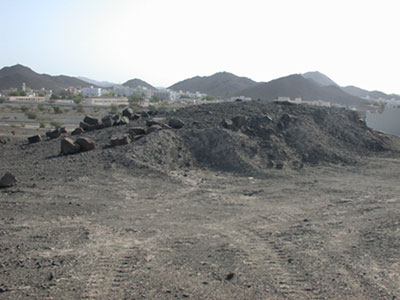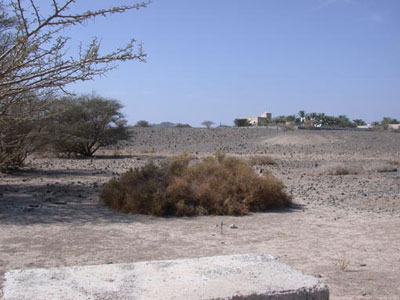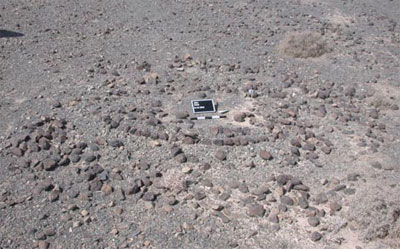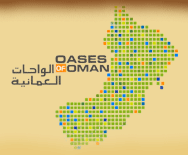Work package: Archaeological investigations in respect to the origin and development of oasis settlements in Oman
Contact Person: Dr. Jutta Häser, German Protestant Institute of Archaeology, Amman
Scientific staff and PhD students: Dr. Jutta Häser, Dr. Jürgen Schreiber, Dipl.-Ing. Martin Grosch
Objectives: The research is focused on processes of transformation throughout history, regarding the architecture and material culture, the economy and ecology of the oasis settlements in a regional and interdisciplinary approach. The aim of the archaeological study is the investigation of the settlement in respect to their establishment and development as well as their ecological setting.
Study locations:
Archaeological survey at Ibra
The survey was carried out from January 29th to February 19th and from October 9th to November 12th 2003. The archaeological survey methods, already tested in the earlier campaigns at Wadi Bani Awf, al-Hamra and Tiwi, were continued to use. More than 400 archaeological sites were recorded and the results of these two campaigns were entered in an “Internet-Geographical Information System” (Internet-GIS) (Häser/ Grosch 2004).
Due to its important strategic position and the rather good ecological situation, we regarded this oasis as a settlement with a long historical tradition.
To sum up the results of the surveys at Ibra and in the area of al-Thabti it can be said, that this area was occupied since the Late Stone Age (6th-5th millennium B.C.). Probably after a hiatus the occupation starts again with the building of Hafit type tombs (late 4th-early 3rd millennium B.C.) in the surroundings of Ibra marking the passages from the foothill area to the mountains. The oasis life started at least in the Umm an-Nar period (3rd millennium B.C.) which is proved by the Umm an-Nar circular building in the centre of the oasis.

In the foreground large boulders probably of a huge Bronze Age building © 2003 DAI Orient-Abteilung Berlin
Like at many places in Oman and the United Arab Emirates the following Wadi Suq period (2nd millennium B.C.) is only represented by a disturbed cemetery.

Remains of a Wadi Suq grave © 2003 DAI Orient-Abteilung Berlin
Intensive settlement activities started again during the Early Iron Age (12th-7th century B.C). Two settlements were discovered, one at the place of the old Umm an-Nar building, the second some kilometres south of it.

Flat hill with remains of an Iron Age settlement ©2003 DAI Orient-Abteilung Berlin
During the Late Iron Age or Samad period (300 B.C.-900 A.D.) the settlement activities shifted on a high hill above the western bench of the Wadi Gharbi.
The settlement of the Early and Middle Islamic period seems to be situated in the same area but slightly north of the hill and on a lower level. During the Late Islamic period the settlement areas were extended as well as the palm gardens, so a large extension of the falaj system must have been managed through this period. This happened not before the rule of the Ya’aruba dynasty in the 17th century A.D.
Support
The archaeological project was financed by the German Institute of Archaeology, the Sultan Qaboos University Muscat and the German Research Foundation. The development of the Internet GIS has been supported by the Technische Fachhochschule Berlin, Fachbereich Kartographie und Fernerkundung.
Publications
| |
Grosch, M. 2003. Entwicklung eines Internet- Geoinformationssystems für archäologische Fundstätten am Beispiel der omanischen Oase Ibra’. Diplomarbeit im Studiengang Kartographie and der Technischen Fachhochschule Berlin. (unpublished)
|
 |
HAEser, J. & Grosch M. 2004. Ein archäologisches Internet- Geoinformationssystem für die Oase Ibra in Oman. Baghdader Mitteilungen 35, 103-119.
|
 |
HAEser, J. & Schulz A. 2004. An Internet-Geographical Information System for Multidisciplinary Research in Oman, in: Magistrat der Stadt Wien, Referat Kulturelles Erbe & Stadtarchäologie Wien (eds.), Enter the Past. The E-way into the Four Dimensions of Cultural Heritage. CAA 2003, Computer Applications and Quantitative Methods in Archaeology. Proceedings of the 31st Conference, Vienna, Austria, April 2003. BAR International Series 1227. 367-370.
|
 |
Schreiber, J. & Haeser, J. 2004. Archaeological survey at Tiwi and its hinterland (Central Oman). Proceedings of the Seminar for Arabian Studies 34, 319-329.
|
 |
Schreiber, J. 2005, Jahresbericht der Orient-Abteilung 2004: Oman. Archäologischer Anzeiger 2004.
|
| |
|
© Jutta Häser
|




